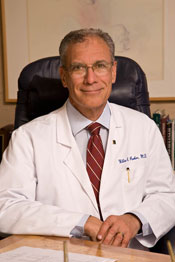As many of you probably know by now, the FDA recently issued a warning saying that morcellation of fibroids during laparoscopic myomectomy (or during laparoscopic hysterectomy) should be avoided because of the risk of uterine leiomyosarcoma (uterine muscle wall cancer).
I disagree with this decision (see reasons below) and ask that women who have benefitted from minimally invasive myomectomy or hysterectomy e-mail the FDA and tell them about the benefits these procedures provided with quicker recovery, less pain, faster return to family or work, etc.
I was an author of a study published in 1994 that showed that the risk of leiomyosarcoma among women operated on for “fibroids” was 1 out of 1,332. This study has been widely used to show the low risk of sarcoma. Our study was conducted at two community hospitals in Santa Monica and represents the incidence of leiomyosarcoma in a population of women in a community having symptoms bothersome enough to warrant surgery. Many of the studies used by the FDA to come to their conclusion were conducted at referral or University hospitals, where women are referred BECAUSE they have sarcoma or have severe symptoms that require the expertise of a specialized physician. These studies are not reliable indicators of how common a disease might be.
Those of you who are interested should look at the actual studies used by the FDA to come to their conclusion. The most obvious flaw with the data is that the article with the largest numbers (by Park), and cited by the FDA, states in the summary that 49 of 22,825 women who underwent surgery for presumed uterine fibroids had leiomyosarcoma.
In fact, as described in the body of the article and confirmed by Dr Nam (the senior author) in an e-mail to me, 26 of the 49 women were referred to Asan Medical Center for further surgery and treatment following a diagnosis of leiomyosarcoma already made elsewhere. Since the denominator of the outside population of women who had surgery for fibroids is unknown (but presumably very large since this is a major referral hospital in Korea), those 26 women must be excluded from the incidence calculation.
Therefore, the incidence of leiomyosarcoma among women operated on for fibroids at Asan Medical Center and who were then discovered to have leiomyosarcoma was 22/22,285 or 1/1000 and Dr. Nam has also confirmed this number in an e-mail to me.
The Cleveland Clinic, which has a very busy gynecologic surgery service, reviewed their records for the past three years and did not find even one woman who had morcellation of a leiomyosarcoma. In my 35 years of practice, operating on 2-4 women with fibroids every week, I have operated on one woman with a leiomyosarcoma. It is a terrible cancer, but is very rare. I am aware of the very unfortunate circumstances regarding Dr. Amy Reed and the morcellation of her uterine leiomyosarcoma in Boston. I cannot imagine how hard this must be for her, her husband and their children. However, banning other women from access to the benefits of minimally invasive surgery seems unwarranted.
Many of the studies quoted by the FDA included other types of surgery where the uterus or fibroids are cut into to remove them from the body. If we are to avoid all forms of morcellation, women with suspected fibroids will have total abdominal hysterectomy as their only surgical option. Laparoscopic hysterectomy for large fibroids that require vaginal or power morcellation, laparoscopic myomectomy, hysteroscopic myomectomy and even abdominal myomectomy would be considered “below the standard of care”. In addition, watchful waiting, medications, uterine artery embolization and focused ultrasound would be improper treatment since a woman “might have a leiomyosarcoma”” and have a delay in diagnosis.
This paradigm shift would eliminate all of the alternatives to hysterectomy developed over the past 20 years, which greatly benefit the vast majority of women who choose them. Furthermore, total abdominal hysterectomy has a higher risk of complications and death than most of these other alternatives. The risk of dying from a hysterectomy approaches 1/1000, no different than the approximate risk of inadvertently morcellating a LMS.
In 2002, a protocol was developed in Japan (Goto protocol) to help make the diagnosis of leiomyosarcoma prior to surgery using MRI with contrast dye and blood tests for the enzyme LDH and its iso-enzymes. I have used this protocol for women who might be suspected of having leiomyosarcoma with excellent results. No woman with normal results has had a leiomyosarcoma. However, because leiomyosarcoma is so rare, it would take a very large study to confirm the excellent results shown in the Goto study. I have recently recommended that the laparoscopy organizations conduct such a study so that we can make the diagnosis of leiomyosarcoma before surgery.
Each medical decision involves weighing potential benefits against possible risks. I think women should be advised of these risks and be allowed to make up their own minds as to what treatment they wish to receive. As it stands, the FDA wants to make this decision for women. The FDA will hold a hearing (open to the public) in a few months to determine their final recommendation. Please make your own thoughts known to the FDA: dsmica@fda.hhs.gov
Sincerely,
Bill Parker, MD
Disclosure: I am a salaried Clinical Professor at UCLA and I do not own any stock or interest in any medical device company. I have nothing to gain or lose financially based on the outcome of the FDA’s final ruling.



